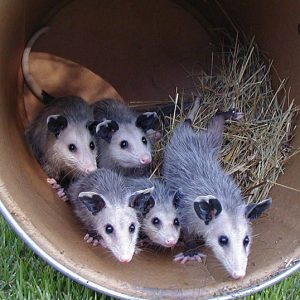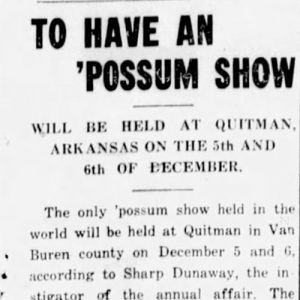calsfoundation@cals.org
Opossums
aka: Possums
aka: Didelphis virginiana
Arkansas opossums (commonly referred to as “possums”) are of the Virginia opossum species Didelphis virginiana and can be found in both rural and urban habitats. The Arkansas Game and Fish Commission tracks opossum populations and oversees an opossum hunting season during the winter months.
As the only marsupials found in North America, opossums have existed for 70–80 million years. They are highly adaptable omnivores who eat a variety of foods including insects, rodents, berries, grasses, leaves, and carrion. The females can have twenty to twenty-five babies in one litter and carry their young in their pouches for up to three months.
Opossums have opposable thumbs on their rear feet and can also grasp with their tails. Contrary to popular belief, adult opossums do not hang by their tails, although some very young opossums are light enough to do so. When threatened, possums hiss and show their teeth. If frightened enough, opossums will faint and go into a catatonic state. “Playing possum,” they go completely stiff and appear to be dead.
Early Arkansans hunted opossums, but their fur had little value. Opossums also provided a source of meat. On October 28, 1886, the Arkansas Gazette printed an article titled, “A Gazette Man Describes a Hempstead County Possum Supper,” recounting a dinner that consisted of “four of the ‘pesky’ but toothsome critters.” In his book Putting the Big Pot in the Little One (1988), Patrick Dunnahoo includes information about a Thanksgiving dinner that consisted of baked opossum with sweet potatoes and pumpkin pie. The “possum dinner” tradition continued via the Polk County Possum Club, which was founded in the early twentieth century in Mena (Polk County). The dinners were held into the 1940s and were revived for a few years in the 1990s.
The town of Mount Ida (Montgomery County) is home of the non-profit group Possums Unlimited. The group’s website promotes eating opossums with the slogan: “Have the nerve, don’t swerve. Eat more possum.”
For additional information:
Johnston, Suzanne D. “Habitat Selection and Ecological Overlap of Raccoons and Virginia Opossums in Arkansas.” MS thesis, Tennessee Technological University, 2016.
Selander, John A., and Gary A. Heidt. Arkansas Mammals: Their Natural History, Classification, and Distribution. Fayetteville: University of Arkansas Press, 1989.
Nathania Sawyer
CALS Encyclopedia of Arkansas
 Mammals
Mammals Young Opossums
Young Opossums  Possum Show Article
Possum Show Article 



Comments
No comments on this entry yet.